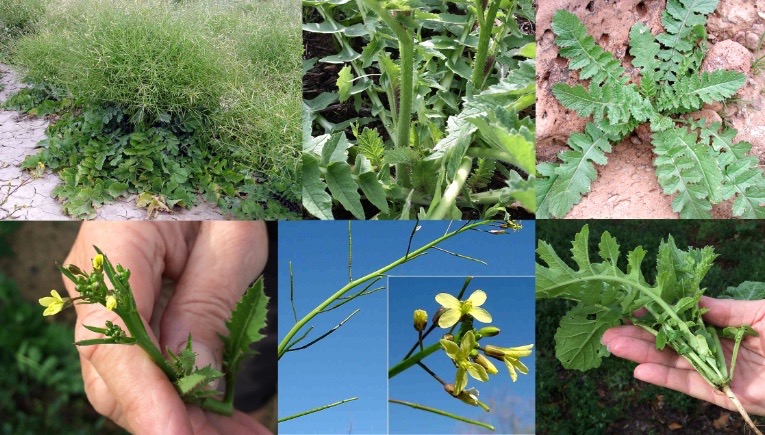Invasive Species Threatens Los Osos
Help Us Kill This Monster!
Yes, sewer construction is over, the holes are covered and the streets are resurfaced, but the project has left behind an insidious reminder. The digging up of practically every street in Los Osos/Baywood Park has engendered a huge crop of Sahara mustard, Brassica tournefortii.
Numerous Old World mustards have invaded North America. Of these Sahara mustard is the newest and by far the worst. It really is a monster! It is a robust, fast-growing, drought-tolerant winter annual that prefers sandy soils. The basal rosette of divided hairy leaves can span three feet in wet years. The nearly leafless flowering stems branch profusely and grow to a height of about two feet, creating the appearance of a shrub from a distance.
These highly invasive plants especially thrive in disturbed soil. And they self-pollinate, so one large plant can produce 16,000 seeds. Sahara Mustard easily and quickly outcompetes native plants that nourish our wildlife. Without native flora, we lose our native fauna.
As shown below, the plants have rough, hairy leaves that get smaller as they move up the stem. They can be as short as 4 inches or as tall as 40 inches. The flower is tiny, pale yellow, composed of four symmetrical petals.

Here’s how Los Osans can help:
1.) Spend at least one hour in your yard and neighborhood pulling up these dangerously invasive weeds.
2.) Email this information to as many people as you can.
3.) If you use Facebook, LIKE us at www.facebook.com/CelebrateLosOsos and check the page out occasionally for updates, information, and pretty photos too.
We are asking all of our 291 volunteers and donors to take at least one hour in the next several weeks to track down and remove these nasty plants wherever you can find them in our community. Pull them up by the root and place in a secured green bin. Don’t assume the county can handle this. Our county deputy agricultural commissioner says, “If Sahara mustard gets a foothold the way veldt grass has, widespread control will simply be impractical.”
You can find Sahara mustard in almost any vacant lot in the sewer-construction zone. Local resident Bonnie Thompson, whose article on this weed appeared recently in the Tribune, said, “Places where I’ve seen burgeoning growth recently include the north side of Santa Ysabel between 10th and 11th Streets, and the corner of 18th and the El Moro bike path; and across the street, on the edge of the open land. And all along Pismo Street, starting at the Middle School and continuing on to the bay.” If you look for it, you will find it. Don’t worry if you accidentally pull another species of mustard; they are all non-native introduced plants.
Weed Pullers
For three weekends, from the end of February, 2016 until mid March, CLO volunteers ventured out in sometime inclement weather to pull out Sahara mustard plants in various lots and roadsides. Lots of large trash bags were filled and disposed of. See pics.
Starting late January 2017 another Sahara mustard harvesting was launched. To see the report and view pics, Click here.
Starting February 2018 another Sahara mustard harvesting was launched, with a new invasive weed added, devil’s thorn. To see the report, Click here.